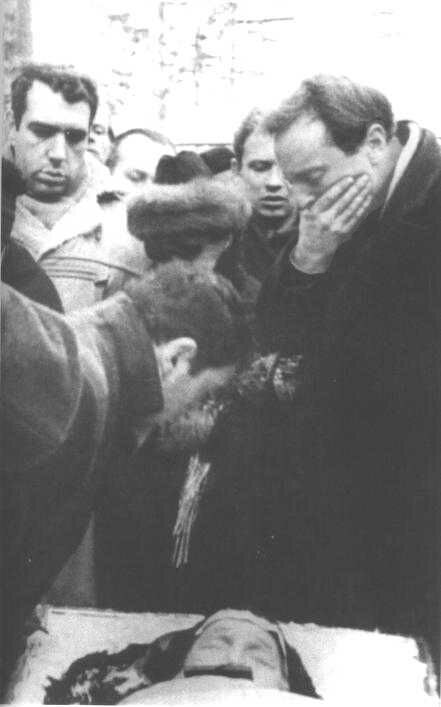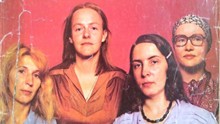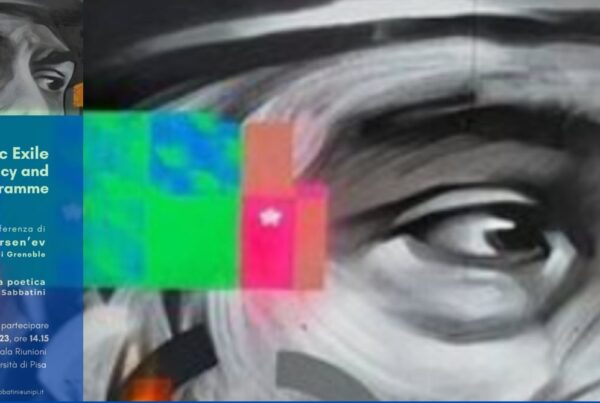
Anna Akhmatova’s funeral. March 10th, 1966. Foto di B. Shvartsman.
Dates: first half of the Sixties
Place: Leningrad
Participants: Iosif Brodskii, Dmitrii Bobyshev, Anatolii Naiman, Evgenii Rein, Viktor Krivulin, Sergei Dovlatov and others
Description:
Anna Akhmatova’s last house in Leningrad was at number 34 Lenin street, where the writer had a bedroom that she also used as a study, in a shared flat. It was here that poets and writers who regarded this last spokeswoman of the Silver Age as a unique model to aspire to gathered regularly.
After Akhmatova’s death in 1966, the young habitués of the writer’s home, including Dmitrii Bobyshev, Anatolii Naiman, Evgenii Rein and Iosif Brodskii, became known as ‘Akhmatova’s Orphans’ (Akhmatovskie siroty) .
The most well-known of the ‘orphans’ is undoubtedly Brodskii, but stylistically the closest to Akhmatova was probably Bobyshev (cf. Sabbatini 2008: 58), who invented the name ‘Akhmatovskie siroty’ in a later article (cf. Savitskii 2002: 137).
Each of the four orphans was deeply influenced by Akhmatova’s personality and activity; during the first decade of the 20th century she was a leading figure in the Acmeist Movement with her first husband Nikolai Gumilëv, shot by the Bolsheviks in 1921. Bobyshev remembers: “It was a meeting with real culture. (…) Somehow Akhmatova was able to make us understand that thanks to her we could feel the global culture in its tangible reality, along with its past and even with its future” (Dolinin 2003: 84).
The relationship of affection and esteem between Akhmatova and the young writers was mutual ; in 1962 the matron of Russian poetry chose Anatolii Naiman as her personal literary secretary (cf. ibid.), with whom she made several translations (including the Canti by Giacomo Leopardi).
The orphans were close to the Filologicheskaia shkola, although the relationship was more of friendship than of artistic fellowship (cf. Savitskii 2002: 137). The orphans represent what has been described as ‘neo-Acmeism’ in Russian poetry; they had well-defined stylistic features, that were distant from the original experimentalism of other poets and writers of the age like Vladimir Erl’, Kostantin Kuz’minskii or Aleksandr Kondratov.
Federico Iocca
[30th June 2021]
Translation by Diletta Bacci
Bibliography
- Dolinin V., Ivanov B., Ostanin B., Severiukhin D. (eds.), Samizdat Leningrada. Literaturnaia ėntsiklopediia, Novoe Literaturnoe Obozrenie, Moskva 2003.
- Sabbatini M., “Quel che si metteva in rima”: cultura e poesia underground a Leningrado, Collana di Europa Orientalis, Salerno 2008.
- Savitskii S., Andegraund. Istoriia i mify leningradskoi neofitsial’noi literatury, Novoe Literaturnoe Obozrenie, Moskva 2002.
To cite this article:
Federico Iocca, Anna Akhmatova house, in Voci libere in URSS. Letteratura, pensiero, arti indipendenti in Unione Sovietica e gli echi in Occidente (1953-1991), a cura di C. Pieralli, M. Sabbatini, Firenze University Press, Firenze 2021-, <vocilibereurss.fupress.net>.
eISBN 978-88-5518-463-2
© 2021 Author(s)
Content license: CC BY 4.0




